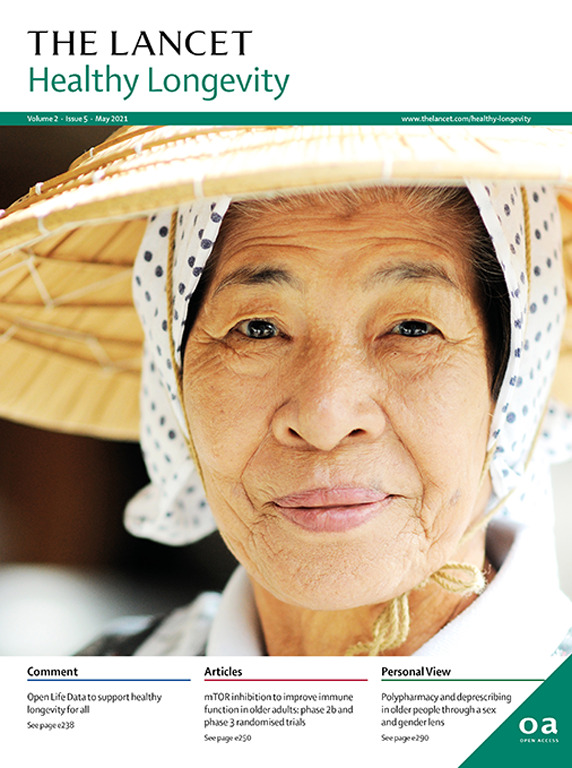Violence across the life course and physical and mental health trajectories in later life: a 13-year population-based cohort study in England
IF 14.6
Q1 GERIATRICS & GERONTOLOGY
引用次数: 0
Abstract
Background
Evidence shows that violence in childhood affects health in adulthood, and violence in adulthood is associated with worse health. However, the extent to which violence-related health disparities persist into later life and whether the gap between victims and non-victims narrows, remains stable, or widens over time are unclear. This study aimed to examine the long-term effects of childhood and lifetime violence on health trajectories in older age.
Methods
The English Longitudinal Study of Ageing is one of the only cohort studies to cover violence across the lifespan alongside health trajectories in later life. Data were collected every 2 years between 2006 and 2019 and experiences of violence and limiting long-standing illness or disability (LLSID) were self-reported. We used logistic multilevel regressions and growth curve modelling to examine associations between parental physical abuse in childhood, lifetime physical or sexual violence, and any violence across the life course, with subsequent change in LLSID and depressive symptoms in later life, adjusted for demographic (age, gender, marital status, and region), socioeconomic (education, occupational class, tenure, and financial hardship), and social (household size and caregiving) attributes. Depressive symptoms were measured with the Centre for Epidemiological Studies Depression scale.
Findings
Of the 9771 participants who responded to the questionnaire, 6171 answered all three questions about experiences of violence and were included in this cohort. Any experience of violence was consistently associated with worse health in older age, including depression scale score of at least 4 (men: adjusted odds ratio 1·99, 95% CI 1·34–2·94; women: 1·38, 1·02–1·86) and LLSID (men: 1·74, 1·08–2·81; women: 2·15, 1·45–3·17). The patterns were evident in men and women.
Interpretation
Physical and mental health disadvantages associated with experiencing violence in childhood and adulthood are sustained throughout later life. There was little evidence that health disparities between victims and non-victims reduce over time. Preventing violence in both childhood and adulthood could promote healthy ageing.
Funding
UK Prevention Research Partnership.
生命过程中的暴力和晚年的身心健康轨迹:英国一项为期13年的人口队列研究
有证据表明,儿童时期的暴力行为会影响成年期的健康,而成年期的暴力行为与健康状况恶化有关。然而,与暴力有关的健康差距在多大程度上持续到以后的生活,以及受害者和非受害者之间的差距是随着时间的推移而缩小、保持稳定还是扩大,这些都不清楚。这项研究的目的是检查童年和终生暴力对老年健康轨迹的长期影响。方法英国老龄化纵向研究是唯一一个将暴力与晚年健康轨迹结合起来进行的队列研究。在2006年至2019年期间,每两年收集一次数据,并自我报告暴力经历和限制长期疾病或残疾(LLSID)。我们使用logistic多水平回归和增长曲线模型来检验童年时期父母身体虐待、终生身体暴力或性暴力以及整个生命过程中的任何暴力之间的关联,以及晚年LLSID和抑郁症状的随后变化,并根据人口统计学(年龄、性别、婚姻状况和地区)、社会经济(教育、职业等级、任期和经济困难)和社会(家庭规模和照顾)属性进行调整。用流行病学研究中心抑郁量表测量抑郁症状。在9771名回答问卷的参与者中,6171人回答了关于暴力经历的所有三个问题,并被纳入本队列。任何暴力经历始终与老年健康状况较差相关,包括抑郁量表得分至少为4分(男性:调整优势比1.99,95% CI 1.34 - 1.94;女性:1.38,1.02 - 1·86)和LLSID(男性:1.74,1.08 - 2·81;女性:2.15,1.45 - 3.17)。这种模式在男性和女性身上都很明显。与儿童期和成年期遭受暴力有关的身心健康不利状况在以后的生活中持续存在。几乎没有证据表明受害者和非受害者之间的健康差距会随着时间的推移而缩小。预防儿童期和成年期的暴力可以促进健康老龄化。资助英国预防研究伙伴关系。
本文章由计算机程序翻译,如有差异,请以英文原文为准。
求助全文
约1分钟内获得全文
求助全文
来源期刊

Lancet Healthy Longevity
GERIATRICS & GERONTOLOGY-
CiteScore
16.30
自引率
2.30%
发文量
192
审稿时长
12 weeks
期刊介绍:
The Lancet Healthy Longevity, a gold open-access journal, focuses on clinically-relevant longevity and healthy aging research. It covers early-stage clinical research on aging mechanisms, epidemiological studies, and societal research on changing populations. The journal includes clinical trials across disciplines, particularly in gerontology and age-specific clinical guidelines. In line with the Lancet family tradition, it advocates for the rights of all to healthy lives, emphasizing original research likely to impact clinical practice or thinking. Clinical and policy reviews also contribute to shaping the discourse in this rapidly growing discipline.
 求助内容:
求助内容: 应助结果提醒方式:
应助结果提醒方式:


